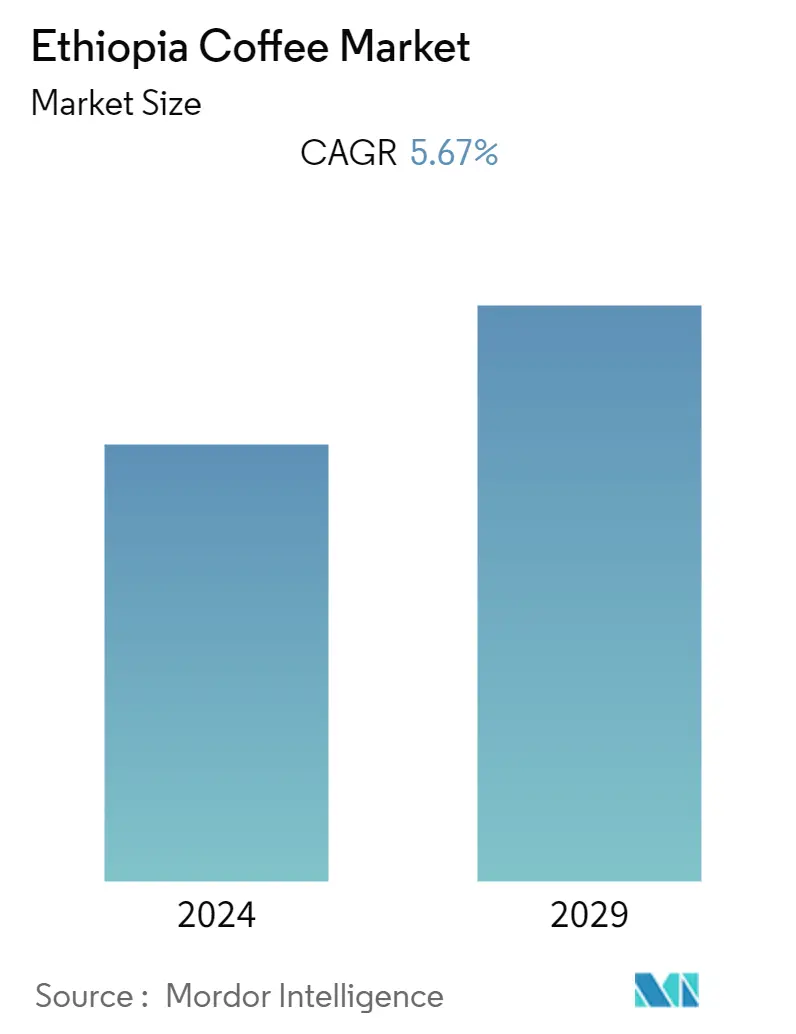Market Size of Ethiopia Coffee Industry

| Study Period | 2019 - 2029 |
| Base Year For Estimation | 2023 |
| Forecast Data Period | 2024 - 2029 |
| Historical Data Period | 2019 - 2022 |
| CAGR | 5.67 % |
| Market Concentration | Low |
Major Players.webp)
*Disclaimer: Major Players sorted in no particular order |
Ethiopian Coffee Market Analysis
Over the next few years, the Ethiopian Coffee Market is expected to register a CAGR of 5.67 percent.
Arabica coffee has its origins in Ethiopia. Ethiopia is one of the largest coffee producers in Africa and the fifth-largest producer in the world. According to the USDA Foreign Agricultural Service, more than 15 million smallholder farmers and other industry participants depend on coffee businesses across the region for their livelihoods, which is Ethiopia's primary export product. In Ethiopia, consumers belonging to the medium-income group are more inclined towards ground coffee, due to its strong aroma and the availability of quality brands. This trend has led to ground coffee becoming the most consumed variety, followed by instant coffee. The convenient availability of this product leads to its vast consumption by people belonging to all demographic groups. Convenience is the foremost factor driving the instant coffee segment, as it can be easily prepared. The fast-moving lifestyle of most consumers is aiding the market for convenient food and beverages. The growing preference for healthy beverages lures amateur coffee drinkers to opt for instant coffee.
Furthermore, in 2021, the Ethiopian Coffee and Tea Authority announced its plans to establish the Ethiopian Coffee Association. The authority had signed a joint agreement with several regional Ethiopian coffee associations. Once established, the Ethiopian Coffee Association's goal is to promote Ethiopian coffee consumption both domestically and globally, as well as to represent all stakeholders in the Ethiopian coffee supply chain in order to boost the market. Health consciousness is also driving the ground coffee market, as consumers prefer green ground coffee because of its chlorogenic acid content, which slows down the absorption of carbohydrates and helps break down fat. Such factors are driving the Ethiopian coffee market.
Ethiopian Coffee Industry Segmentation
Coffee is a brewed drink prepared from roasted coffee beans, which are the seeds of berries from certain coffee species. Roasted beans are ground and then brewed with near-boiling water to produce the beverage known as coffee. The Ethiopian coffee market is segmented by product type and distribution channel. Based on product type, the market is segmented into whole-bean, ground coffee, and instant coffee. Based on the distribution channel, the market is segmented into on-trade and off-trade. Off-trade is further classified into supermarkets and hypermarkets, convenience stores, online retail stores, and other off-trade channels. The market sizing has been done in value terms in USD for all the abovementioned segments.
| Product Type | |
| Whole-bean | |
| Ground Coffee | |
| Instant Coffee |
| Distribution Channel | ||||||
| On-trade (Cafes and Foodservice) | ||||||
|
Ethiopia Coffee Market Size Summary
The Ethiopian coffee market is poised for significant growth, driven by its rich heritage as the birthplace of Arabica coffee and its status as a leading producer in Africa and globally. Coffee is a vital economic driver in Ethiopia, supporting millions of smallholder farmers and serving as the country's primary export. The market is characterized by a strong preference for ground coffee among medium-income consumers, attributed to its robust aroma and quality. Instant coffee is also gaining traction due to its convenience, aligning with the fast-paced lifestyles of many consumers. The establishment of the Ethiopian Coffee Association aims to bolster both domestic and international consumption, representing stakeholders across the coffee supply chain. Health-conscious consumers are increasingly drawn to green ground coffee for its potential health benefits, further propelling market growth.
Ethiopia's coffee industry benefits from extensive production in forested highland areas, with a significant portion of its output exported as green coffee beans, enhancing its competitive edge in the global market. The rise in internet penetration and e-commerce is reshaping consumer behavior, particularly among younger demographics, by facilitating access to diverse coffee products and influencing purchasing decisions through social media and online marketing. The market is highly competitive, with both local and international players like Klatch Coffee, Nestle SA, and Starbucks actively innovating and expanding their offerings. Initiatives such as partnerships with research organizations and the development of training centers underscore efforts to enhance coffee quality and sustainability, aiming to maximize Ethiopia's coffee production potential.
Ethiopia Coffee Market Size - Table of Contents
-
1. MARKET DYNAMICS
-
1.1 Market Drivers
-
1.2 Market Restraints
-
1.3 Porter's Five Forces Analysis
-
1.3.1 Threat of New Entrants
-
1.3.2 Bargaining Power of Buyers/Consumers
-
1.3.3 Bargaining Power of Suppliers
-
1.3.4 Threat of Substitute Products
-
1.3.5 Intensity of Competitive Rivalry
-
-
-
2. MARKET SEGMENTATION
-
2.1 Product Type
-
2.1.1 Whole-bean
-
2.1.2 Ground Coffee
-
2.1.3 Instant Coffee
-
-
2.2 Distribution Channel
-
2.2.1 On-trade (Cafes and Foodservice)
-
2.2.2 Off-trade
-
2.2.2.1 Supermarkets/Hypermarkets
-
2.2.2.2 Convenience Stores
-
2.2.2.3 Online Retail Stores
-
2.2.2.4 Other Off-trade Channels
-
-
-
Ethiopia Coffee Market Size FAQs
What is the current Ethiopia Coffee Market size?
The Ethiopia Coffee Market is projected to register a CAGR of 5.67% during the forecast period (2024-2029)
Who are the key players in Ethiopia Coffee Market?
Klatch Coffee, Nestle SA, Enjoy Better Coffee (Mokate), Wild Coffee Company and Hadero Coffee are the major companies operating in the Ethiopia Coffee Market.

